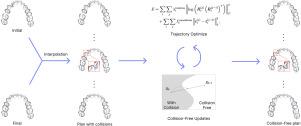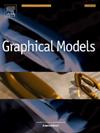指指正畸治疗的无碰撞路径规划方法
IF 2.2
4区 计算机科学
Q2 COMPUTER SCIENCE, SOFTWARE ENGINEERING
引用次数: 0
摘要
数字正畸的快速发展突出了对平衡计算效率和临床可靠性的自动化治疗计划系统的迫切需求。然而,现有的方法仍然存在一些局限性,包括过多的临床医生参与(占治疗计划时间的35%以上),依赖经验定义的关键框架,以及有限的生物力学合理性,特别是在严重牙齿拥挤的情况下。本文提出了一种新的无碰撞优化框架来同时解决这些问题。我们的方法定义了在中间时间框架内评估每个牙齿姿势的总运动能量函数。使用最陡下降策略迭代最小化该能量。采用回滚机制:如果在更新期间检测到齿间渗透,则步长重复减半,直到消除碰撞。该框架允许灵活控制中间框架的数量,以严格限制每颗牙齿的位移,将其限制在每10至14天0.2毫米的平移或2°旋转。临床评估表明,即使在复杂的情况下,该算法也能产生理想的临床有效的牙齿移动计划,同时大大减少了人工干预的需要。本文章由计算机程序翻译,如有差异,请以英文原文为准。

Collision-free path planning method for digital orthodontic treatment
The rapid evolution of digital orthodontics has highlighted a critical need for automated treatment planning systems that balance computational efficiency with clinical reliability. However, existing methods still suffer from several limitations, including excessive clinician involvement (accounting for over 35% of treatment planning time), reliance on empirically defined key frames, and limited biomechanical plausibility, particularly in cases of severe dental crowding. This paper proposes a novel collision-free optimization framework to address these issues simultaneously. Our method defines a total movement energy function evaluated over each tooth’s pose at intermediate time frames. This energy is minimized iteratively using a steepest descent strategy. A rollback mechanism is employed: if inter-tooth penetration is detected during an update, the step size is halved repeatedly until collisions are eliminated. The framework allows flexible control over the number of intermediate frames to enforce a strict constraint on per-tooth displacement, limiting it to 0.2 mm translation or rotation every 10 to 14 days. Clinical evaluations show that the proposed algorithm can generate desirable and clinically valid tooth movement plans, even in complex cases, while significantly reducing the need for manual intervention.
求助全文
通过发布文献求助,成功后即可免费获取论文全文。
去求助
来源期刊

Graphical Models
工程技术-计算机:软件工程
CiteScore
3.60
自引率
5.90%
发文量
15
审稿时长
47 days
期刊介绍:
Graphical Models is recognized internationally as a highly rated, top tier journal and is focused on the creation, geometric processing, animation, and visualization of graphical models and on their applications in engineering, science, culture, and entertainment. GMOD provides its readers with thoroughly reviewed and carefully selected papers that disseminate exciting innovations, that teach rigorous theoretical foundations, that propose robust and efficient solutions, or that describe ambitious systems or applications in a variety of topics.
We invite papers in five categories: research (contributions of novel theoretical or practical approaches or solutions), survey (opinionated views of the state-of-the-art and challenges in a specific topic), system (the architecture and implementation details of an innovative architecture for a complete system that supports model/animation design, acquisition, analysis, visualization?), application (description of a novel application of know techniques and evaluation of its impact), or lecture (an elegant and inspiring perspective on previously published results that clarifies them and teaches them in a new way).
GMOD offers its authors an accelerated review, feedback from experts in the field, immediate online publication of accepted papers, no restriction on color and length (when justified by the content) in the online version, and a broad promotion of published papers. A prestigious group of editors selected from among the premier international researchers in their fields oversees the review process.
 求助内容:
求助内容: 应助结果提醒方式:
应助结果提醒方式:


